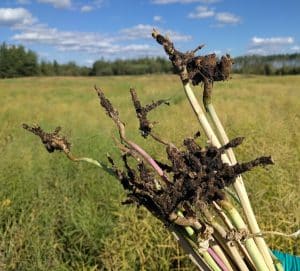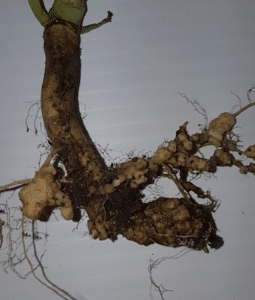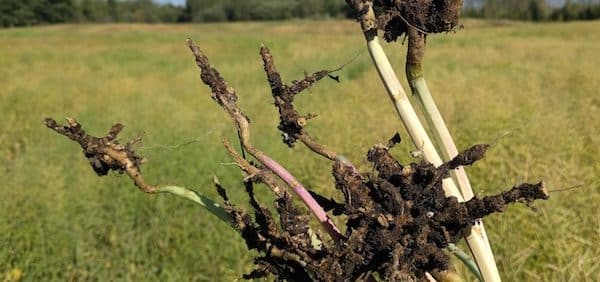The number of confirmed clubroot cases continues to rise across central Alberta, in the southeast Peace Region and in Crop Districts 9A and 9B in Saskatchewan. Keep scouting. Clubroot has the potential to infect canola anywhere in Western Canada, and early detection will prevent unexpected high losses from the disease.
Farmers with standing or just-cut crop still have an opportunity to scout for clubroot. Take advantage of an opportunity to scout while waiting to swath or combine. Although clubroot can be detected for some time after swathing, it becomes more difficult to recognize as galls decay. If found before it gets serious, farmers can take steps to prevent significant yield loss in subsequent years. Preventative measures can start this fall with seed and rotation decisions for 2018.


How to scout
Start with plants that have obvious symptoms. Look for patches of plants that are ripening prematurely. Often plants growing in the fringe around low wet areas will be large and green and healthy. If these plants are dead instead, this could be a clubroot patch. And because the plants are already dead, the galls may be decayed. In this case, stems may pull out of the ground with no roots attached – which can make clubroot seem like root rot. In this situation, dig down and look for brownish sawdust-like material around where the tap root would be. This is likely decayed galls. DNA tests can confirm this.
While at this location, move beyond these dead areas by a foot or two and check the nearest living plants. Carefully shovel up the tap root and knock away soil to check for galls. When plants are still living, galls are white and fleshy, like a potato. Large galls can be the size of a plum, and grape-sized galls are common.
As fields dry down, diseased patches are harder to see because the whole field is starting to yellow. In this situation, another scouting option is to check for patches of green weeds and exceptionally thin canola. Weeds are often worse in patches where plants died off prematurely or were less competitive due to clubroot, and some of these weeds – brassica relatives such as shepherd’s purse, for example – are also clubroot hosts. If they have galls, then clubroot is present in the field.
If fields have no diseased patches (the obvious first places to scout), then dig up the roots of 40-50 random plants near field entrances (where equipment parks or unfolds) or any other high-traffic areas, such as near bin-yards, beehives or oil wells. Plants that appear healthy can still have galls – and these galls will produce spores that can be spread around the field and then infect canola the next time around. High traffic areas are the first places to look because clubroot is soil-borne and it often spreads with equipment movement. Drill openers or tillage tools carrying clubroot-infested soil tend to drop this soil soon after starting work in a field.
How does clubroot end up on an area far away from field entrances? While field machinery is the most common way to spread large amounts of infested soil, clubroot spores can also spread by wind and water and on animals, for example. Through these vectors, infested soil could be dropped anywhere and if these locations tend to favour clubroot (low-pH pockets, low areas that tend to have higher soil moisture, or weedy areas that could have host weeds on a regular basis), the disease can flare up and move into the field from these unexpected start points.
The seed decision
If clubroot is found on the farm, definitely start shopping for clubroot-resistant (CR) varieties.
If clubroot is found anywhere in the municipality, county or district, CR varieties will also reduce the build of spores in a field if (when) clubroot moves onto your farm. Using CR varieties in 2018 in Crop Districts 9A and 9B in Saskatchewan and the affected Peace Region, for example, could prevent a repeat of widespread yield loss experienced in central Alberta before CR varieties came along. Earlier deployment of CR would have significantly reduced the severity and extreme build-up of spores in now badly infested fields where clubroot was likely present but undetected and spread around for at least a couple of years.
If you don’t know whether clubroot is in your area, CR varieties can be a useful prevention tool. The risk of using a CR too early and contributing to breaking of the resistance is small compared to the risk from not using a CR variety early and having the disease escalate quickly to very costly levels.
Use the following checklist to decide whether a CR variety is right for your farm. If any one statement is “false”, a CR variety may be the best choice.
1. I vigorously checked all of my fields (not just those in canola this year) to confirm that clubroot is not found on my farm. (True or False)
2. I sent in soil samples from fields that will be in canola next year and they tested negative for the pathogen. (True or False)
3. My neighbours have checked their fields and they don’t have clubroot. (True or False)
4. I have not heard of any clubroot in my community. (True or False)
5. No outside equipment/traffic has entered my fields since I last scouted them for clubroot. (True or False)
Other management considerations to scout and manage clubroot
Crop rotation. If visible symptoms (galls) are found in a field, CR varieties need to be used ini combination with a diverse crop rotation (at least 3 years between canola crops). This will reduce the risk of breaking resistance through the selection of more aggressive pathotypes within the pathogen population. Note that increasing spore loads on infected fields can occur even when growing a resistant variety.
Reduced tillage. When soil moves, clubroot moves. If possible, reduce fall tillage as tillage tools move a lot of soil within fields and, without good sanitation, from field to field. Tillage can also lead to more wind and water erosion of soil, which will also move clubroot. If ruts are an issue, consider tillage for only those affected areas. Harrowing of residue and application of fall fertilizer can also move soil. Think sanitation for these tools, too.
DNA tests. Don’t bother with the $100 soil DNA tests in areas that already have clubroot. Just grow CR varieties. In other areas, DNA tests could confirm the presence of clubroot DNA before major plant symptoms appear. If one field tests positive, assume the whole farm has clubroot. Keep in mind that a positive is a positive but a negative test is not necessarily a negative. It might just mean you took samples from those places in a field that didn’t have clubroot DNA. The pathogen is extremely variable within fields.
Liming. Adding lime to increase soil pH and available calcium has been shown to significantly reduce clubroot severity in other places and other crops around the world. Research on liming to manage clubroot in Western Canada is being revisited, and early results are promising. Because liming has other benefits in low pH soils, especially as it relates to nutrient availability and soil tilth, it will not hurt to add lime now (before the research is complete) to at-risk fields. (On clubroot and soil pH: While higher pH may reduce clubroot severity, it does not provide clubroot immunity. One case of clubroot identified in Saskatchewan this year was in a field with pH around 7.5. pH can also be highly variable in a field, so hot spots can flare up in lower pH areas, then spread around the field.) Liming can be done to hot-spots if entire field applications aren’t practical or warranted.
Perennial ryegrass. Seeding clubroot-infested areas to perennial grass will greatly reduce traffic to this area. Grassing an area will also reduce erosion and movement of infested soil from that area. The question is what to do with the grass. It might be best to leave it be as cutting and baling could pick up and move soil to other parts of the farm. Grazing may be lower risk, but cattle can also move soil on their hooves and excrement.
Set different field entrances and exits. Exiting the field away from a known infested entrance will also reduce the risk of spread. If possible, create a new field ‘exit’ in a dry area and designate it as an EXIT ONLY. Restricting all entry into a field (except when absolutely necessary for field operations) could also help minimize clubroot spread from affected fields.
Further reading:
Canola Encyclopedia section on clubroot
Canola Performance Trials variety database

